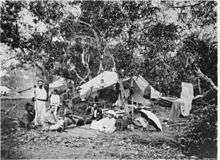Redscar Bay
Redscar Bay is a bay to the northwest of Port Moresby, Papua New Guinea, extending for about 4 miles (6.4 km) between Cape Suckling and Redscar Head,[1] also situated between Kekeni Rocks and Lagava Island.
Geography
A significant number of rivers and streams flow into the bay, including the Vanapa, Veimauri, and Aroa rivers, and to the northeast is Varivari Island. There is a head of the same name on the coast, a prominent rock which is red in color.[2] Galley Reach, a relatively wide inlet which extends through the bar across the estuary of the bay, is considered a hazard to boats.[3] The Pariwara Islets, two small islets with some rocks, lie 1–2 miles northwestward of Redscar Head, and Redscar Hill rises above the head to a height of 575 feet (175 m).[4] Between Cape Suckling and Redscar there is a coral reef extending 0.5 to 1 mile offshore.[3] The shoreline is low and swampy, with dense woodland.[3]
History and archaeology

Gold was first discovered in Papua New Guinea in 1852 as accidental traces in pottery from Redscar Bay on the Papua Peninsula. Since, numerous items have been discovered in the bay area, and the British Museum is in possession of 44 items, mainly arrows, and spears, an adze, a cooking pot, a necklace, a skirt, and a paddle.[5] Sir Peter Scratchley led an expedition to the area in 1885. The Rogers Airfield was located near the bay and several planes crashed nearby during World War II, including P-39D Airacobra 41-6945, P-39F Airacobra 41-7136, B-25H Mitchell 43-4341, P-47D Thunderbolt, and P-47D "Hi Topper" 42-8081.[2]
Demographics
The Kabadi or Motu languages are spoken in the bay area.[6]
References
- ↑ The Australia directory. Vol.2. 2nd-6th ed. 1879. pp. 485–6.
- 1 2 "Redscar Bay". Pacificwrecks.com. Retrieved 2 March 2014.
- 1 2 3 Prostar Sailing Directions 2004 New Guinea Enroute. ProStar Publications. 1 January 2004. p. 133. ISBN 978-1-57785-569-9.
- ↑ Findlay, Alexander George (1877). A Directory for the Navigation of the South Pacific Ocean: With Descriptions of Its Coasts, Islands, Etc., from the Strait of Magalhaens to Panama, and Those of New Zealand, Australia, Etc., Its Winds, Currents, and Passages. R. H. Laurie. p. 808.
- ↑ "Collection:Redscar Bay". British Museum. Retrieved 2 March 2014.
- ↑ Reports of the Cambridge Anthropological Expedition to Torres Straits Volume Iii Linguistics. CUP Archive. p. 510. ISBN 978-1-00-142336-4.
External links
- Map of rivers in the area and Gallery Reach
Coordinates: 9°8′49″S 146°50′8″E / 9.14694°S 146.83556°E